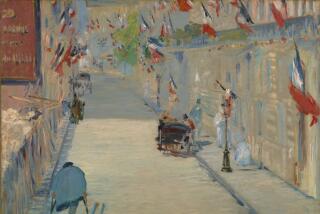Book review: ‘Van Gogh: The Life’
Van Gogh
The Life
Steven Naifeh and Gregory White Smith
Random House: 953 pp., $40
Vincent Van Gogh is an extraordinary artist about whom everything seems to be known. His brilliant work and tragic life, combined with a paper trail of letters to his art-dealer brother, Theo, have made him an irresistible subject for art historians, biographers, journalists, filmmakers, medical specialists and psychologists since his death from a gunshot wound in 1890.
The Dutch painter of dazzling landscapes and searing portraits may be permanently engraved in the public imagination as a mad, self-destructive genius, but scholars continue to probe every last detail of his 37 years on Earth. Two years ago, the Van Gogh Museum in Amsterdam — which maintains a vast archive as well as an art collection — published a six-volume edition of about 900 letters, freshly translated, annotated, illustrated by 4,300 images and available online.
And now, drawing heavily on the letters and the museum’s resources, Steven Naifeh and Gregory White Smith have written the most extensive biography of Van Gogh. A tour de force beginning with his parents’ family tree and ending with speculation about who fired the deadly shot, it’s an enormous achievement. So big, in fact, that the notes — about 5,000 typewritten pages — were published separately online, at https://www.vangoghbiography.com.
The authors, who also teamed on a Pulitzer Prize-winning biography of American abstract expressionist painter Jackson Pollock, call their new book “Van Gogh: The Life,” not “Van Gogh: A Life,” as if it’s the last word. But many questions remain. Informative as the letters are, they don’t cover everything. What’s more, they were written by a deeply troubled man who apparently suffered from manic depression, syphilis and a form of epilepsy. Reading his life story is like riding an endless roller coaster of delusional highs and lows.
Desperate for the comfort of family and community, the rewards of an honorable career and, finally, a way of making art that would fulfill a sort of religious quest, he was so needy, demanding and unstable that he repeatedly crashed and burned.
“I believe he has always been insane and that his suffering and ours was a result of it,” his mother wrote to Theo’s wife, Jo, at a bleak point in 1889. Even Theo, Vincent’s most sympathetic and stalwart supporter, couldn’t bear to be in constant contact with his brother. The authors’ thorough probing of Van Gogh’s relationships with family members, artists, business colleagues, models and Sien Hoornick, a prostitute who lived with him in the Hague, can be painful to read.
His journey from youthful sketches to the evanescent, almost electrically charged body of work produced in his final years is equally fraught with impossible dreams and self-doubt. But Naifeh and Smith reveal a keen intellect, an avid reader and a passionate observer of other artists’ work who progressed from labored figure studies to inspired outbursts of creative energy. Far from an artistic flash in the pan, he pursued his calling with dogged determination against nearly insurmountable odds.
Packed with information about Van Gogh’s rotten teeth, spending sprees and children he may have fathered as well as the evolution of his brushwork and palette, this book may indeed be “the life” of Van Gogh. Yet the story is not complete.
“No one knows” is the phrase leading into the authors’ investigations of why the artist left Paris for Arles in February 1888 and why he cut off part of his ear after falling out with fellow artist Paul Gauguin in December 1889. In the case of the ear, Naifeh and Smith can’t resist filling in blanks with a breathless imagined scenario of the “shipwrecked” artist looking into the mirror above his washstand, grabbing a straight razor and slashing at “the offending flesh.”
No one knows what happened, either, on the afternoon when Van Gogh went out to paint near the town of Auvers, about 20 miles north of Paris, and was fatally wounded. The standard account is that he shot himself and staggered back to his lodgings, where he died two days later. But no weapon was found and a doctor’s report suggests that the gun was fired from a distance.
Picking up on a rumor that the artist was accidentally shot by young boys — told to art historian John Rewald by villagers in the 1930s — Naifeh and Smith theorize that Rene Secretan, a teenager who had harassed the artist, was the culprit. Although the authors argue their case in an appendix, admitting that they have no evidence, their treatment of the mystery seems to be as concerned with selling books as with getting at the truth.
All their work considered, though, these are minor flaws in a sweepingly authoritative, astonishingly textured book.
A former Times staff writer, Muchnic is the author of “Odd Man In: Norton Simon and the Pursuit of Culture.”
More to Read
Sign up for our Book Club newsletter
Get the latest news, events and more from the Los Angeles Times Book Club, and help us get L.A. reading and talking.
You may occasionally receive promotional content from the Los Angeles Times.









